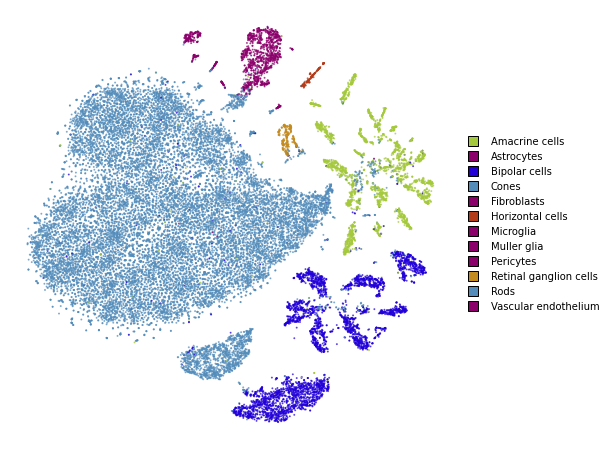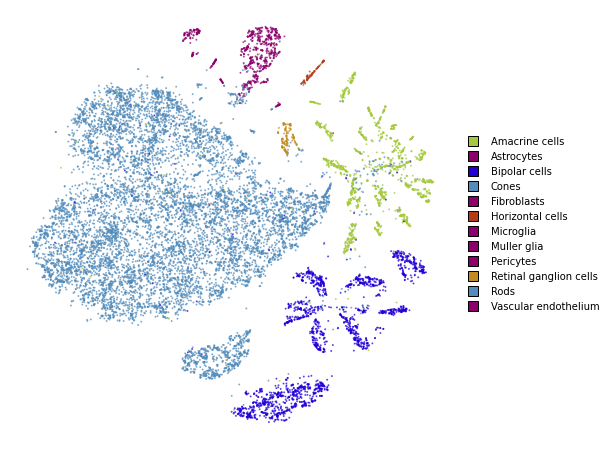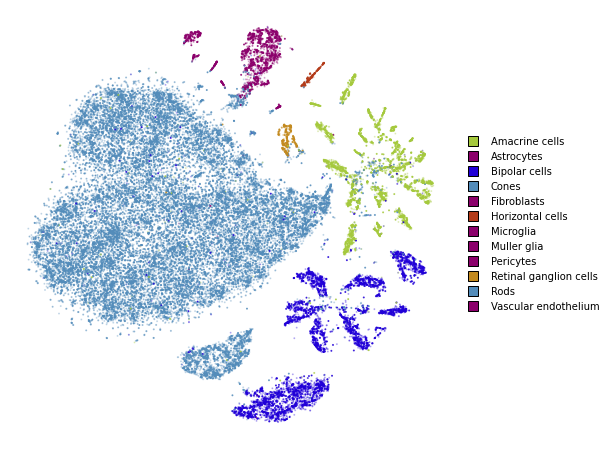Simple usage
This notebook demonstrates basic usage of the openTSNE library. This is sufficient for almost all use-cases.
from openTSNE import TSNE
from examples import utils
import numpy as np
from sklearn.model_selection import train_test_split
import matplotlib.pyplot as plt
Load data
In most of the notebooks, we will be using the Macosko 2015 mouse retina data set. This is a fairly well-known and well explored data set in the single-cell literature making it suitable as an example. The preprocessed data set can be downloaded from http://file.biolab.si/opentsne/benchmark/macosko_2015.pkl.gz.
import gzip
import pickle
with gzip.open("data/macosko_2015.pkl.gz", "rb") as f:
data = pickle.load(f)
x = data["pca_50"]
y = data["CellType1"].astype(str)
print("Data set contains %d samples with %d features" % x.shape)
Data set contains 44808 samples with 50 features
Create train/test split
x_train, x_test, y_train, y_test = train_test_split(x, y, test_size=.33, random_state=42)
print("%d training samples" % x_train.shape[0])
print("%d test samples" % x_test.shape[0])
30021 training samples
14787 test samples
Run t-SNE
We’ll first create an embedding on the training data.
tsne = TSNE(
perplexity=30,
metric="euclidean",
n_jobs=8,
random_state=42,
verbose=True,
)
%time embedding_train = tsne.fit(x_train)
--------------------------------------------------------------------------------
TSNE(early_exaggeration=12, n_jobs=8, random_state=42, verbose=True)
--------------------------------------------------------------------------------
===> Finding 90 nearest neighbors using Annoy approximate search using euclidean distance...
--> Time elapsed: 8.82 seconds
===> Calculating affinity matrix...
--> Time elapsed: 0.70 seconds
===> Calculating PCA-based initialization...
--> Time elapsed: 0.21 seconds
===> Running optimization with exaggeration=12.00, lr=2501.75 for 250 iterations...
Iteration 50, KL divergence 5.1633, 50 iterations in 2.5187 sec
Iteration 100, KL divergence 5.0975, 50 iterations in 2.5269 sec
Iteration 150, KL divergence 5.0648, 50 iterations in 2.5661 sec
Iteration 200, KL divergence 5.0510, 50 iterations in 2.3758 sec
Iteration 250, KL divergence 5.0430, 50 iterations in 2.4623 sec
--> Time elapsed: 12.45 seconds
===> Running optimization with exaggeration=1.00, lr=30021.00 for 500 iterations...
Iteration 50, KL divergence 3.0008, 50 iterations in 2.6407 sec
Iteration 100, KL divergence 2.7927, 50 iterations in 3.9767 sec
Iteration 150, KL divergence 2.6962, 50 iterations in 5.1542 sec
Iteration 200, KL divergence 2.6384, 50 iterations in 6.5875 sec
Iteration 250, KL divergence 2.5970, 50 iterations in 8.1932 sec
Iteration 300, KL divergence 2.5673, 50 iterations in 9.5913 sec
Iteration 350, KL divergence 2.5431, 50 iterations in 11.2144 sec
Iteration 400, KL divergence 2.5244, 50 iterations in 11.6824 sec
Iteration 450, KL divergence 2.5088, 50 iterations in 12.7052 sec
Iteration 500, KL divergence 2.4950, 50 iterations in 14.4997 sec
--> Time elapsed: 86.25 seconds
CPU times: user 3min 13s, sys: 2.91 s, total: 3min 15s
Wall time: 1min 53s
utils.plot(embedding_train, y_train, colors=utils.MACOSKO_COLORS)

Transform
openTSNE is currently the only library that allows embedding new points into an existing embedding.
%time embedding_test = embedding_train.transform(x_test)
===> Finding 15 nearest neighbors in existing embedding using Annoy approximate search...
--> Time elapsed: 3.54 seconds
===> Calculating affinity matrix...
--> Time elapsed: 0.04 seconds
===> Running optimization with exaggeration=4.00, lr=0.10 for 0 iterations...
--> Time elapsed: 0.00 seconds
===> Running optimization with exaggeration=1.50, lr=0.10 for 250 iterations...
Iteration 50, KL divergence 213718.9013, 50 iterations in 0.4314 sec
Iteration 100, KL divergence 212177.4468, 50 iterations in 0.4447 sec
Iteration 150, KL divergence 211186.1793, 50 iterations in 0.4477 sec
Iteration 200, KL divergence 210471.7728, 50 iterations in 0.4193 sec
Iteration 250, KL divergence 209921.5693, 50 iterations in 0.4285 sec
--> Time elapsed: 2.17 seconds
CPU times: user 10.4 s, sys: 864 ms, total: 11.2 s
Wall time: 6.72 s
utils.plot(embedding_test, y_test, colors=utils.MACOSKO_COLORS)

Together
We superimpose the transformed points onto the original embedding with larger opacity.
fig, ax = plt.subplots(figsize=(8, 8))
utils.plot(embedding_train, y_train, colors=utils.MACOSKO_COLORS, alpha=0.25, ax=ax)
utils.plot(embedding_test, y_test, colors=utils.MACOSKO_COLORS, alpha=0.75, ax=ax)
